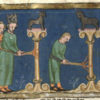Iconoclasm has taken many forms across world cultures.
I just remember the type that smash icons. Some factions smashed icons that they felt were not adequate or proper representations. They weren’t all absolutely opposed to any image at all. In fact, Catholicism has had iconoclastic movements without actually rejecting any representation at all.
In part, there have been disagreements regarding the sainthood of various figures, and though some sections of Catholicism embraced variations on native iconography, other groups rejected and destroyed these variant images. There were disagreements on the appropriateness of various solar cross symbols, or the use of pentagrams, etc. The pentagram was for a time used to symbolize the five wounds of Christ. Only later in Christian history was it considered fully unacceptable. In fact, the early use of a pentagram in demonology was likely as a symbol of Christ’s protective sacrifice rather than an elemental symbol.
Pentagram still means protection to Witches and to Police (take a good look at a sheriff’s Badge). Yes. Jungian philosophy would say that despite iconoclastic movements, symbolism can continue to survive in human unconscious memory despite its conscious rejection.
Symbols themselves survive, yes. This is why the version of Iconoclasm I remembered seemed so foolish. Yes. A destruction of a superficial relic without any real power to attack the spirit behind it. Another classical iconoclasm would be the use or rejection of demonic imagery in design of temples, and “demonic” imagery has actually been present in temples world wide.
We need to be politically correct now? Exactly, but that wasn’t the original argument. The original concern was a difference in perception of the relationship between the demonic and the divine which has three different models just between Islam, Judaism and Christianity, let alone between different sects of Christianity. But to simplify it, the school that embraced the use of demonic imagery in Christianity operated under the belief that though unfavoured by God, the demons were given a reprieve to linger in the world and keep what power they had to affect it. Thus demonic imagery was a combination of mixed respect and an effort to use the images they would acknowledge as having authority. Essentially with the notion that only their own kind would scare them, and on the other hand the other camp believed that using demonic imagery was giving them more power than they had, and a presence that they shouldn’t be allowed, so the imagery had to be destroyed.
That one seems to have survived. That they should be ignored at least in Christian circles. Indeed, and now in some still philosophically Christian groups the old conceptions of God are more or less rejected even, though they still call themselves Christian. Though it’s rejection is not really a new notion. It has been debated since the early founding.
Nestor showed that. Yes. An early Christian priest/theologian. He denied that Christ could be fully human and fully divine, and in fact the Gnostics didn’t disappear quickly from the founding of Christianity. Some of their own iconography was preserved and still exists.
Gnosticism can easily creep into even “proper” Christian thought. It is arguably what allowed “universal” Catholicism. Otherwise Christianity might have been more akin to Judaism in its structure if it even became more than a Jewish sub-sect. It’s not commonly known, but there is a group of Jews who do see Jesus as having been the messiah.
Yes, I remember seeing one at a large convention I attended. It was rather surreal seeing a man in Hasidic dress praying to Christ.
Your thoughts are welcome. Be well friends.
Travis Saunders
Dragon Intuitive
~science,mysticism,spirituality~



Leave a Reply